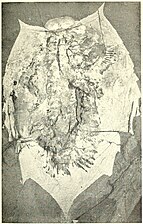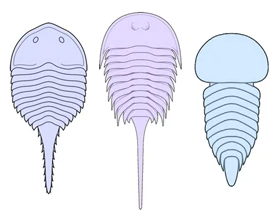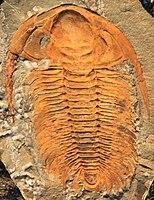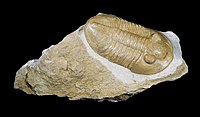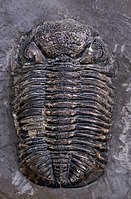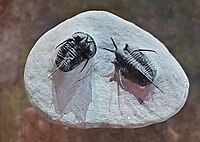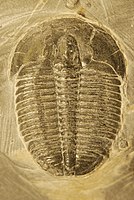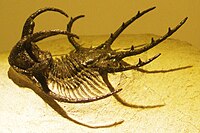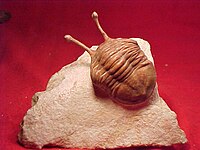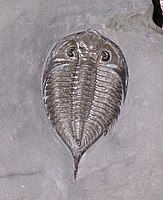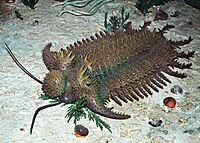三葉虫
出典: フリー百科事典『ウィキペディア(Wikipedia)』 (2024/02/19 04:49 UTC 版)
分類
系統位置
| ||||||||||||||||||||||||||||||||||||||||||||||||
| 節足動物における三葉虫の系統位置 |
-
ヘルメティア
三葉虫はナラオイア、ヘルメティア、シャンダレラなどとも共に三葉形類(Trilobitomorpha)をなし、これは更に光楯類やシドネイアなどと共にArtiopoda類という化石節足動物の一大分類群をなしている[7][38]。その中で三葉虫はConciliterga類(ヘルメティア、サペリオンなど)や Kwanyinaspis との類縁関係が多くの系統解析に支持される[39][40][41][42][43][44][45]。
Artiopoda類は現生節足動物の4つの大きな区分である鋏角類・多足類・甲殻類・六脚類に並ぶ一群としての位置はほぼ認められているが、これらの群との類縁関係については定説がない(鋏角類と大顎類のいずれかに近縁、もしくはそれらより基盤的)[46]。古くは三葉形類から触角が退化消失して前脚が鋏角に変化することで鋏角類が起源し、光楯類やカブトガニ類がその祖先形質を色濃く残した原始的な鋏角類という説があったが[47][48][49]、鋏角は触角に相同であることが多方面な解析に証明される・光楯類は鋏角類的性質をもたないことが解明されるなどの発展に連れて、その説の基準が否定的になった[50][51][52]。
下位分類
 | この節は検証可能な参考文献や出典が全く示されていないか、不十分です。(2024年1月) |
古生物学の分類学的辞書ともいえる1953年の『Treatise of Invertebrate Paleontology[53]』においては、三葉虫種全てを三葉虫綱(Class Trilobita)としてまとめている。三葉虫の化石は、ほとんどのものが背側に備わった石灰質の外骨格(背板とハイポストーマ)のみが化石化しているため、分類の定義は背板上の形質に頼らざるを得ない。これは、付属肢などの生体部の形状を重要視して分類同定を行う現生の節足動物群とは根本的に異なるので注意が必要である。つまり不完全な記載分類学的研究ではあるが、その研究の歴史は古く、18世紀後半には三葉虫を節足動物の中の独立したグループとする見解が提出され、また分類学の始祖とされるスウェーデンのカール・フォン・リンネも三葉虫を数種記載している。ただし現今では新種報告の数が著しい減少傾向にあるとされ、主流となる三葉虫研究の方向性の転換も求められているようである。
三葉虫綱内における高次分類群間の類縁関係については、1950年代以降に飛躍的に増加した個体発生過程の情報を用いた研究結果に頼るところが大きい。しかしながら、化石化されない生体部の情報がほぼ完全に欠如しているといったデメリットなどにも起因し、研究者間の見解の一致には未だ遠く、今後も大幅な改訂があるかもしれない。
2010年代現在、22,000種以上の三葉虫が記載されている。昔今の文献によって目は3から11、目不明の科は4から58ほどあるとされる[1]。以下は Fortey 1997 による8目の体系を基に列挙する。
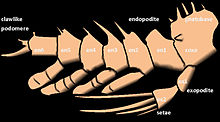
- アグノスタス目 Agnostida
- アグノスタス亜目 Agnostina とエオディスカス亜目 Eodiscina があり、双方とも体サイズが
矮小 ()化しており(通常5-6 mm程度)、前者は2・後者は3の胸節で構成される胸部、そして頭部とよく似た尾部といった特徴を持つ。特にアグノスタス亜目は、頭部に通常認められる複眼を持たない。一方、エオディスカス亜目には abathochroal eye と呼ばれる特殊な形状の複眼が備わる[13]。 - 付属肢はアグノスタス亜目の数種から知られており、他の三葉虫とは大きく異なる特徴を備えている。これは、頭部の脚が5対ある・外肢の附属体は刺毛状であり葉状ではない・前2対の外肢は特に長大・胸部と尾部の脚は外肢が短縮して内肢が櫛状に発達、などが挙げられる[54][55]。この付属肢形態の相違をもとに、アグノスタス目(少なくともアグノスタス亜目)を三葉虫綱に含めない見解もある[1]。化石記録はカンブリア紀からオルドビス紀。
Itagnostus interstrictus(アグノスタス目) | Paradoxides sp.(レドリキア目) |
Paralejurus sp.(コリネクソカス目) | Pseudoasaphus praecurrens(アサフス目) |
Phacops speculator(ファコプス目) | Cyphaspis sp.(プロエトゥス目) |
Elrathia kingii(プティコパリア目) | Ceratarges sp.(リカス目) |
- レドリキア目 Redlichiida
- 平滑な体型をしており、防御姿勢は他の三葉虫ほど丸くない[11]。尾部は通常非常に小さく、胸節の数は多い[6]。顔線を持たないオレネルス亜目 Olenellina と、顔線を有するレドリキア亜目 Redlichiina を含む。化石記録はカンブリア紀のみ。
- コリネクソカス目 Corynexochida
- 肥大した頭鞍を持つグループ。頭部付属肢が特化していたと考える研究者もいる。主にカンブリア紀に繁栄したコリネクソカス亜目 Corynexochina と、オルドビス紀以降に栄えた比較的のっぺりとしたイラエナス亜目 Illaenina、団扇状の尾部を持つティサノペルティス(スクテラム)亜目 Leiostegiina がある。化石記録はカンブリア紀前期からデボン紀中期。
- アサフス目 Asaphida
- のっぺりとした体を持つグループ。幼生期は浮遊生活を送っていたと考えられている。化石記録はオルドビス紀からデボン紀中期。
- ファコプス目 Phacopida
- オルドビス紀以降に非常に栄えたグループ。棘の多い体をもつケイルルス亜目 Cheirurina、特徴的なコブのある頭鞍をもつカリメネ亜目 Calymenina、非常に発達した眼をもつものが多いファコプス亜目 Phacopina が含まれる。眼は個眼が独立して集まった schizochroal eye[13]。化石記録はカンブリア紀末からデボン紀後期。
- プロエトゥス目 Proetida
- 楕円形状の体と曲玉状の眼をもつグループで出現が最も遅く(オルドビス紀)、一番後(ペルム紀末)まで生き残っている。しばしば同種のみがまとまって見つかることも多いため、集団で生活していたとも考えられている。
- プティコパリア目 Ptychopariida
- 比較的特徴のない三葉虫のグループ。最も原始的と考えられているプティコパリア亜目 Ptychopariina、カンブリア紀後期からオルドビス紀に繁栄した胸節が多節化しているオレヌス亜目 Olenina、西洋の竪琴型の頭を持つハルペス亜目 Harpina が含まれる。研究者によっては最後のハルペス類をハルペス目として独立させている。化石記録はカンブリア紀からデボン紀後期。
- リカス目 Lichida
- 装飾の多い頭鞍と、体の縁に棘を持つことの多いグループ。防御姿勢がとれない代わりに棘が発達したとする研究者もいる。以前は別々の目とされていたオドントプレウラ類 Odontopleuridae とダメセラ類 Damesellidae を含む。化石記録はカンブリア紀後期からデボン紀中期。
主な種類
ダルマニテス | |
テラタスピス | ワリセロプス |
- アルバーテラ Albertella
- ロッキー山脈などのカンブリア紀層で発見される。全長8 cm。
- アークティヌルス Arctinurus
- ヨーロッパや北アメリカのシルル紀層で発見される。大型で、幅は10 cmくらいある。「三葉虫の王様」とも呼ばれる[56]。
- アサフス(ネオアサフス)・コワレフスキー Asaphus kowalewskii
- ロシア・サンクトペテルブルク近郊のヴォルホフ川流域のオルドビス紀層で発見される。眼柄で突き出した複眼が特徴。全長2.5 cmほど。
- ダルマニテス Dalmanites
- 世界中で発見されている、古生代中頃の最も代表的な三葉虫。幅3 cm。
- ダイフォン Deiphon
- イギリスのシルル紀層で発見される。棘が多い。全長4 cm。
- エオレドリキア Eoredlichia
- 中国のカンブリア紀層で発見される。付属肢と消化系が知られる数少ない種類の一つ。体長12 cm(尾部の長い棘を含むと約20 cm)ほど。
- エルラシア・キンギ Elrathia kingi
- アメリカ合衆国のユタ州のカンブリア紀層で発見される。全長1.6 cmほど。
- オレノイデス Olenoides
- 北アメリカのカンブリア紀層で発見される。最も研究が進んでいる三葉虫の一つで、唯一に特化した脚や尾毛が知られる三葉虫でもある[17]。体長10 cmほど。
- パラドキシデス Paradoxides
- カンブリア紀の大型(全長40 cm前後)の三葉虫。
- フィリップシア Phillipsia
- 日本でも発見された。古生代後期。小型(幅2 cm)。
- テラタスピス Terataspis
- アメリカ合衆国のニューヨーク州やカナダのオンタリオ州で発見されている。70 cmほどになるとみられるリカス目の最大級の三葉虫[57]。
- トリアルトルス Triarthrus
- 北アメリカ、ヨーロッパと中国のオルドビス紀層で発見される。付属肢や消化系がよく知られ、最初に卵が発見された三葉虫でもある[37]。体長5 cmほど。
- ワリセロプス Walliserops
- モロッコのデボン紀層で発見される。トライデント状に突き出した角が特徴で、それをカブトムシのように闘争に使われたという説がある[58]。体長4 cmほど(角を除く)。
- ^ a b c Paterson, John R. (2020-01). “The trouble with trilobites: classification, phylogeny and the cryptogenesis problem” (英語). Geological Magazine 157 (1): 35–46. doi:10.1017/S0016756819000426. ISSN 0016-7568.
- ^ a b c d Holmes, James D.; Budd, Graham E. (2022-11-04). “Reassessing a cryptic history of early trilobite evolution” (英語). Communications Biology 5 (1): 1–9. doi:10.1038/s42003-022-04146-6. ISSN 2399-3642.
- ^ Gutiérrez-Marco, Juan C.; Sá, Artur A.; García-Bellido, Diego C.; Rábano, Isabel; Valério, Manuel (2009-05-01). “Giant trilobites and trilobite clusters from the Ordovician of Portugal”. Geology 37 (5): 443–446. doi:10.1130/G25513A.1. ISSN 0091-7613.
- ^ a b Rudkin, David M.; Young, Graham A.; Elias, Robert J.; Dobrzanski, Edward P. (2003-01). “The world's biggest trilobite—Isotelus rex new species from the upper Ordovician of northern Manitoba, Canada” (英語). Journal of Paleontology 77 (1): 99–112. doi:10.1666/0022-3360(2003)077<0099:TWBTIR>2.0.CO;2. ISSN 0022-3360.
- ^ Fortey, Richard A.; Rushton, A. W. A. (1980). “Acanthopleurella Groom 1902: origin and life-habits of a miniature trilobite”. Bulletin of the British Museum (Natural History) Geology 33: 79–89. ISSN 0007-1471.
- ^ a b c d e f Hughes, N. C. (2003-02-01). “Trilobite Tagmosis and Body Patterning from Morphological and Developmental Perspectives” (英語). Integrative and Comparative Biology 43 (1): 185–206. doi:10.1093/icb/43.1.185. ISSN 1540-7063.
- ^ a b c d Hou, Xianguang. (1997). Arthropods of the Lower Cambrian Chengjiang fauna, southwest China. Bergström, Jan, 1938-. Oslo: Scandinavian University Press. ISBN 82-00-37693-1. OCLC 38305908
- ^ a b Ortega-Hernández, Javier; Janssen, Ralf; Budd, Graham E. (2017-05-01). “Origin and evolution of the panarthropod head – A palaeobiological and developmental perspective” (英語). Arthropod Structure & Development 46 (3): 354–379. doi:10.1016/j.asd.2016.10.011. ISSN 1467-8039.
- ^ a b c 斉, 小泉 (1972). “阿武隈山地・高倉山層群(ペルム紀)のPhillipsiidae新属三葉虫”. 地球科学 26 (1): 19–25. doi:10.15080/agcjchikyukagaku.26.1_19.
- ^ “三葉虫 アカドパラドキシデス | 東北大学総合学術博物館”. www.museum.tohoku.ac.jp. 2022年4月15日閲覧。
- ^ a b Laibl, Lukáš; Esteve, Jorge; Fatka, Oldřich (2016-12-30). “Enrollment and thoracic morphology in paradoxidid trilobites from the Cambrian of the Czech Republic” (英語). Fossil Imprint 72 (3-4): 161–171. doi:10.14446/FI.2016.161. ISSN 2533-4069.
- ^ Losso, Sarah R.; Affatato, Pauline; Nanglu, Karma; Ortega-Hernández, Javier (2023-12-20). “Convergent evolution of ventral adaptations for enrolment in trilobites and extant euarthropods” (英語). Proceedings of the Royal Society B: Biological Sciences 290 (2013). doi:10.1098/rspb.2023.2212. ISSN 0962-8452. PMC PMC10730288. PMID 38113938.
- ^ a b c d Schoenemann, Brigitte (2021-03-01). “An overview on trilobite eyes and their functioning”. Arthropod Structure & Development 61: 101032. doi:10.1016/j.asd.2021.101032. ISSN 1467-8039.
- ^ サウスウッド 2007, p. 77.
- ^ a b c 鈴木, 雄太郎 (2002). “三葉虫 :研究の総説および多様性の変遷”. 化石 72: 21-38.
- ^ Edgecombe, Gregory D.; Fortey, Richard A. (2023-01). “A novel antennal form in trilobites” (英語). Journal of Paleontology 97 (1): 152–157. doi:10.1017/jpa.2022.59. ISSN 0022-3360.
- ^ a b Losso, Sarah R.; Ortega-Hernández, Javier (2022-08-01). “Claspers in the mid-Cambrian Olenoides serratus indicate horseshoe crab–like mating in trilobites” (英語). Geology 50 (8): 897–901. doi:10.1130/G49872.1. ISSN 0091-7613.
- ^ “Epipodites or Epipods”. Center of 'Orsten' Research and Exploration. 2008年10月28日時点のオリジナルよりアーカイブ。2015年9月19日閲覧。
- ^ Hou, Jin-bo; Hughes, Nigel C.; Hopkins, Melanie J. (2021-04-02). “The trilobite upper limb branch is a well-developed gill” (英語). Science Advances 7 (14). doi:10.1126/sciadv.abe7377. ISSN 2375-2548. PMC PMC8011964. PMID 33789898.
- ^ Siveter, Derek J.; Fortey, Richard A.; Briggs, Derek E. G.; Siveter, David J.; Sutton, Mark D. (2021-11). Zhang, Xi‐Guang. ed. “The first Silurian trilobite with three‐dimensionally preserved soft parts reveals novel appendage morphology” (英語). Papers in Palaeontology 7 (4): 2245–2253. doi:10.1002/spp2.1401. ISSN 2056-2799.
- ^ Hou, Jin-bo; Hughes, Nigel C.; Hopkins, Melanie J. (2023-05). “Gill grooming in middle Cambrian and Late Ordovician trilobites” (英語). Geological Magazine 160 (5): 905–910. doi:10.1017/S001675682300002X. ISSN 0016-7568.
- ^ Hou, Jin-Bo; Hughes, Nigel C.; Hopkins, Melanie J.; Shu, Degan (2023-08). “Gill function in an early arthropod and the widespread adoption of the countercurrent exchange mechanism” (英語). Royal Society Open Science 10 (8). doi:10.1098/rsos.230341. ISSN 2054-5703. PMC PMC10427831. PMID 37593708.
- ^ Ramsköld, L.; Edgecombe, G.D. (1996-01). “Trilobite appendage structure — Eoredlichia reconsidered” (英語). Alcheringa: An Australasian Journal of Palaeontology 20 (4): 269–276. doi:10.1080/03115519608619471. ISSN 0311-5518.
- ^ a b Bicknell, Russell D. C.; Holmes, James D.; Edgecombe, Gregory D.; Losso, Sarah R.; Ortega-Hernández, Javier; Wroe, Stephen; Paterson, John R. (2021-01-27). “Biomechanical analyses of Cambrian euarthropod limbs reveal their effectiveness in mastication and durophagy” (英語). Proceedings of the Royal Society B: Biological Sciences 288 (1943): 20202075. doi:10.1098/rspb.2020.2075. ISSN 0962-8452. PMC PMC7893260. PMID 33499790.
- ^ Whittington, H. B. (1997), “The Trilobite Body.”, in Kaesler, R. L., Treatise on Invertebrate Paleontology, Part O, Arthropoda 1, Trilobita, revised. Volume 1: Introduction, Order Agnostida, Order Redlichiida, Boulder, CO & Lawrence, KA: The Geological Society of America, Inc. & The University of Kansas, pp. 137–169, ISBN 978-0-8137-3115-5
- ^ Lerosey-Aubril, Rudy; Hegna, Thomas A.; Olive, Sébastien (2011-06). “Inferring internal anatomy from the trilobite exoskeleton: the relationship between frontal auxiliary impressions and the digestive system” (英語). Lethaia 44 (2): 166–184. doi:10.1111/j.1502-3931.2010.00233.x. ISSN 0024-1164.
- ^ Fatka, O.; Lerosey-Aubril, R.; Budil, P.; Rak, Š. (2012-12-06). “Fossilised guts in trilobites from the Upper Ordovician Letná Formation (Prague Basin, Czech Republic)”. Bulletin of Geosciences: 95–104. doi:10.3140/bull.geosci.1329. ISSN 1802-8225.
- ^ a b Kraft, Petr; Vaškaninová, Valéria; Mergl, Michal; Budil, Petr; Fatka, Oldřich; Ahlberg, Per E. (2023-10). “Uniquely preserved gut contents illuminate trilobite palaeophysiology” (英語). Nature 622 (7983): 545–551. doi:10.1038/s41586-023-06567-7. ISSN 1476-4687.
- ^ McCormick, Tim; Fortey, Richard A. (1998-04). “Independent testing of a paleobiological hypothesis: the optical design of two Ordovician pelagic trilobites reveals their relative paleobathymetry” (英語). Paleobiology 24 (2): 235–253. doi:10.1666/0094-8373(1998)024[0235:ITOAPH]2.3.CO;2. ISSN 0094-8373.
- ^ Woolfe, K. J. (1990-11-01). “Trace fossils as paleoenvironmental indicators in the Taylor group (Devonian) of Antarctica”. Palaeogeography, Palaeoclimatology, Palaeoecology 80 (3): 301–310. doi:10.1016/0031-0182(90)90139-X. ISSN 0031-0182.
- ^ サウスウッド 2007, p. 78.
- ^ サウスウッド 2007, p. 79.
- ^ Hughes, Nigel C.; Hong, Paul S.; Hou, Jinbo; Fusco, Giuseppe (2017). “The Development of the Silurian Trilobite Aulacopleura koninckii Reconstructed by Applying Inferred Growth and Segmentation Dynamics: A Case Study in Paleo-Evo-Devo”. Frontiers in Ecology and Evolution 5. doi:10.3389/fevo.2017.00037. ISSN 2296-701X.
- ^ Lerosey-Aubril, Rudy; Laibl, Lukáš (2021-07-01). “Protaspid larvae are unique to trilobites”. Arthropod Structure & Development 63: 101059. doi:10.1016/j.asd.2021.101059. ISSN 1467-8039.
- ^ Speyer, Stephen E.; Chatterton, Brian D.E. (1989-11). “Trilobite larvae and larval ecology” (英語). Historical Biology 3 (1-2): 27–60. doi:10.1080/08912968909386512. ISSN 0891-2963.
- ^ Laibl, L; Fatka, O; Crônier, C; Budil, P (2014-03-17). “Early ontogeny of the Cambrian trilobite Sao hirsuta from the Skryje-Týřovice Basin, Barrandian area, Czech Republic”. Bulletin of Geosciences 89 (2): 293-309.
- ^ a b Hegna, Thomas A.; Martin, Markus J.; Darroch, Simon A.F. (2017-03). “Pyritized in situ trilobite eggs from the Ordovician of New York (Lorraine Group): Implications for trilobite reproductive biology” (英語). Geology 45 (3): 199–202. doi:10.1130/G38773.1. ISSN 0091-7613.
- ^ Lerosey-Aubril, Rudy; Zhu, Xuejian; Ortega-Hernández, Javier (2017-12). “The Vicissicaudata revisited – insights from a new aglaspidid arthropod with caudal appendages from the Furongian of China” (英語). Scientific Reports 7 (1): 11117. doi:10.1038/s41598-017-11610-5. ISSN 2045-2322. PMC 5593897. PMID 28894246.
- ^ Ortega‐Hernández, Javier; Legg, David A.; Braddy, Simon J. (2013). “The phylogeny of aglaspidid arthropods and the internal relationships within Artiopoda” (英語). Cladistics 29 (1): 15–45. doi:10.1111/j.1096-0031.2012.00413.x. ISSN 1096-0031.
- ^ Du, Kun‐sheng; Ortega‐Hernández, Javier; Yang, Jie; Zhang, Xi‐guang (2019-06). “A soft‐bodied euarthropod from the early Cambrian Xiaoshiba Lagerstätte of China supports a new clade of basal artiopodans with dorsal ecdysial sutures” (英語). Cladistics 35 (3): 269–281. doi:10.1111/cla.12344. ISSN 0748-3007.
- ^ Chen, Xiaohan; Ortega-Hernández, Javier; Wolfe, Joanna M.; Zhai, Dayou; Hou, Xianguang; Chen, Ailin; Mai, Huijuan; Liu, Yu (2019-08-06). “The appendicular morphology of Sinoburius lunaris and the evolution of the artiopodan clade Xandarellida (Euarthropoda, early Cambrian) from South China”. BMC Evolutionary Biology 19 (1): 165. doi:10.1186/s12862-019-1491-3. ISSN 1471-2148. PMC PMC6685191. PMID 31387545.
- ^ Jiao, De-Guang; Du, Kun-Sheng; Zhang, Xi-Guang; Yang, Jie; Eggink, Daniel (2022-05). “A new small soft-bodied non-trilobite artiopod from the Cambrian Stage 4 Guanshan Biota” (英語). Geological Magazine 159 (5): 730–734. doi:10.1017/S0016756821001254. ISSN 0016-7568.
- ^ Schmidt, Michel; Hou, Xianguang; Zhai, Dayou; Mai, Huijuan; Belojević, Jelena; Chen, Xiaohan; Melzer, Roland R.; Ortega-Hernández, Javier et al. (2022-03-28). “Before trilobite legs: Pygmaclypeatus daziensis reconsidered and the ancestral appendicular organization of Cambrian artiopods” (英語). Philosophical Transactions of the Royal Society B: Biological Sciences 377 (1847). doi:10.1098/rstb.2021.0030. ISSN 0962-8436. PMC PMC8819370. PMID 35125003.
- ^ Zhang, Maoyin; Liu, Yu; Hou, Xianguang; Ortega-Hernández, Javier; Mai, Huijuan; Schmidt, Michel; Melzer, Roland R.; Guo, Jin (2022-08). “Ventral Morphology of the Non-Trilobite Artiopod Retifacies abnormalis Hou, Chen & Lu, 1989, from the Early Cambrian Chengjiang Biota, China” (英語). Biology 11 (8): 1235. doi:10.3390/biology11081235. ISSN 2079-7737.
- ^ Berks, Harry O.; Lunde Nielsen, Morten; Flannery‐Sutherland, Joseph; Thorshøj Nielsen, Arne; Park, Tae‐Yoon S.; Vinther, Jakob (2023-05). “A possibly deep branching artiopodan arthropod from the lower Cambrian Sirius Passet Lagerstätte (North Greenland)” (英語). Papers in Palaeontology 9 (3). doi:10.1002/spp2.1495. ISSN 2056-2799.
- ^ Giribet, Gonzalo; Edgecombe, Gregory D. (2019-06-17). “The Phylogeny and Evolutionary History of Arthropods” (英語). Current Biology 29 (12): R592–R602. doi:10.1016/j.cub.2019.04.057. ISSN 0960-9822.
- ^ Størmer, Leif (1944) (English). On the relationships and phylogeny of fossil and recent Arachnomorpha: a comparative study on Arachnida, Xiphosura, Eurypterida, Trilobita, and other fossil Arthropoda. Oslo: Jacob Dybwad. OCLC 961296639
- ^ Stürmer, Wilhelm; Bergström, Jan (1978-06-01). “The arthropod Cheloniellon from the devonian hunsrück shale” (英語). Paläontologische Zeitschrift 52 (1): 57–81. doi:10.1007/BF03006730.
- ^ Stürmer, Wilhelm; Bergström, Jan (1981-12-01). “Weinbergina, a xiphosuran arthropod from the devonian hunsrück slate” (ドイツ語). Paläontologische Zeitschrift 55 (3): 237–255. doi:10.1007/BF02988142.
- ^ Scholtz, Gerhard; Edgecombe, Gregory (2005-04-27), Koenemann, Stefan; Jenner, Ronald, eds. (英語), Heads, Hox and the phylogenetic position of trilobites, 16, CRC Press, pp. 139–165, doi:10.1201/9781420037548.ch6, ISBN 978-0-8493-3498-6 2022年4月15日閲覧。
- ^ Dunlop, Jason (2005-11-30). “New ideas about the euchelicerate stem-lineage”. Acta Zoologica Bulgarica.
- ^ Lamsdell, James C. (2013-01-01). “Revised systematics of Palaeozoic ‘horseshoe crabs’ and the myth of monophyletic Xiphosura”. Zoological Journal of the Linnean Society 167 (1): 1–27. doi:10.1111/j.1096-3642.2012.00874.x. ISSN 0024-4082.
- ^ “Treatise on Invertebrate Paleontology”. paleo.ku.edu. 2022年4月15日閲覧。
- ^ Müller, Klaus J.; Walossek, Dieter (1987-08-15) (英語). Morphology, ontogeny, and life habit of Agnostus pisiformis from the Upper Cambrian of Sweden. 19. Universitetsforlaget. doi:10.18261/8200075117-1987-01. ISBN 978-82-00-07511-0
- ^ Moysiuk, J.; Caron, J.-B. (2019-01-16). “Burgess Shale fossils shed light on the agnostid problem” (英語). Proceedings of the Royal Society B: Biological Sciences 286 (1894): 20182314. doi:10.1098/rspb.2018.2314. ISSN 0962-8452. PMC PMC6367181. PMID 30963877.
- ^ 土屋健『カラー図解 古生物たちのふしぎな世界 繁栄と絶滅の古生代3億年史』講談社、2017年、119頁。ISBN 978-4-06-502018-0。
- ^ a b 川崎悟司『絶滅したふしぎな巨大生物』PHP研究所、2011年6月10日、28-29頁。ISBN 978-4-569-79636-9。
- ^ Gishlick, Alan D.; Fortey, Richard A. (2023-01-24). “Trilobite tridents demonstrate sexual combat at 400 Mya” (英語). Proceedings of the National Academy of Sciences 120 (4). doi:10.1073/pnas.2119970120. ISSN 0027-8424. PMC PMC9942788. PMID 36649420.
- ^ Daley, Allison C.; Antcliffe, Jonathan B.; Drage, Harriet B.; Pates, Stephen (2018-05-22). “Early fossil record of Euarthropoda and the Cambrian Explosion” (英語). Proceedings of the National Academy of Sciences 115 (21): 5323–5331. doi:10.1073/pnas.1719962115. ISSN 0027-8424. PMC PMC6003487. PMID 29784780.
- ^ Lieberman, Bruce S. (2002-07). “Phylogenetic analysis of some basal early Cambrian trilobites, the biogeographic origins of the Eutrilobita, and the timing of the Cambrian radiation” (英語). Journal of Paleontology 76 (4): 692–708. doi:10.1666/0022-3360(2002)076<0692:PAOSBE>2.0.CO;2. ISSN 0022-3360.
- ^ a b Paterson, John R.; Edgecombe, Gregory D.; Lee, Michael S. Y. (2019-03-05). “Trilobite evolutionary rates constrain the duration of the Cambrian explosion” (英語). Proceedings of the National Academy of Sciences 116 (10): 4394–4399. doi:10.1073/pnas.1819366116. ISSN 0027-8424. PMC PMC6410820. PMID 30782836.
- ^ a b Bault, Valentin; Balseiro, Diego; Monnet, Claude; Crônier, Catherine (2022-07-01). “Post-Ordovician trilobite diversity and evolutionary faunas”. Earth-Science Reviews 230: 104035. doi:10.1016/j.earscirev.2022.104035. ISSN 0012-8252.
三葉虫と同じ種類の言葉
固有名詞の分類
- 三葉虫のページへのリンク
